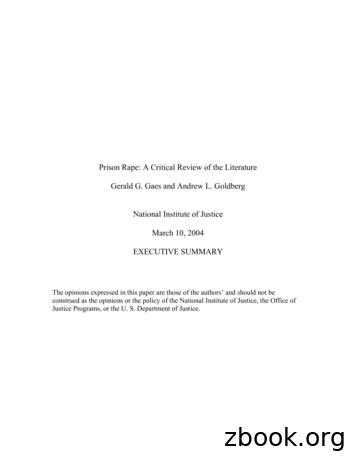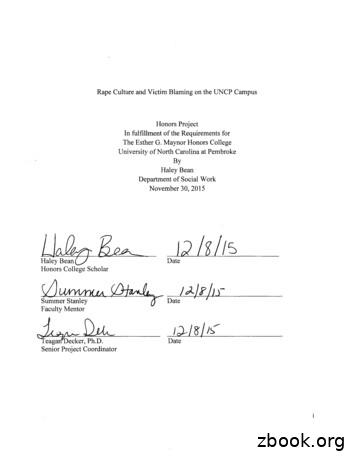Statutory Rape: A Guide To State Laws And Reporting .
Statutory Rape: A Guide toState Laws and ReportingRequirementsPrepared for:Office of the Assistant Secretary for Planning andEvaluation, Department of Health and Human ServicesPrepared by:Asaph GlosserKaren GardinerMike FishmanThe Lewin GroupDecember 15, 2004
AcknowledgementsWork on this project was funded by the Office of the Assistant Secretary for Planning andEvaluation in the U.S. Department of Health and Human Services under a contract to TheLewin Group. This report benefited greatly from the oversight and input of Jerry Silverman, theASPE Project Officer.In addition, we would like to acknowledge the assistance of a number of reviewers. SarahBrown, Eva Klain, and Brenda Rhodes Miller provided us with valuable guidance and insightsinto legal issues and the policy implications of the laws and reporting requirements. Theircomments improved both the content and the organization of the paper.At The Lewin Group, Shauna Brodsky reviewed drafts and provided helpful comments.The Authors
Table of ContentsI.EXECUTIVE SUMMARY . ES-1A. Background. ES-11. Criminal Laws. ES-12. Reporting Requirements. ES-2B. Implications for Program Staff and Policy Makers . ES-3C. Structure of Report. ES-3II. INTRODUCTION. 1A. Project Description. 1B. Methodology . 21. Terminology . 22. Types of Laws . 33. Sources . 3III. SUMMARY OF CURRENT STATE LAWS. 5A. Statutory Rape—Criminal Offenses . 51. Sexual Intercourse with Minors. 52. Definition of Offenses . 9B. Child Abuse Reporting Requirements. 101. Inclusion of Statutory Rape in Reporting Requirements . 102. Mandatory Reporters . 123. Who to Report to. 134. State Response. 14IV. STATE LAWS . 17ALABAMA . 18ALASKA . 20ARIZONA . 22ARKANSAS . 24CALIFORNIA . 26COLORADO. 29CONNECTICUT . 31DELAWARE. 33DISTRICT OF COLUMBIA . 35FLORIDA. 37GEORGIA. 39HAWAII. 41IDAHO. 43ILLINOIS. 45
INDIANA . 48IOWA . 50KANSAS . 52KENTUCKY . 54LOUISIANA. 57MAINE . 59MARYLAND. 62MASSACHUSETTS . 64MICHIGAN . 65MINNESOTA . 67MISSISSIPPI. 69MISSOURI . 71MONTANA. 73NEBRASKA . 75NEVADA . 77NEW HAMPSHIRE . 79NEW JERSEY . 81NEW MEXICO. 83NEW YORK. 85NORTH CAROLINA . 88NORTH DAKOTA . 90OHIO . 92OKLAHOMA. 94OREGON. 96PENNSYLVANIA . 99RHODE ISLAND . 101SOUTH CAROLINA . 103SOUTH DAKOTA . 105TENNESSEE. 107TEXAS . 110UTAH . 112VERMONT. 115VIRGINIA . 117
WASHINGTON . 119WEST VIRGINIA. 121WISCONSIN. 123WYOMING . 125
Executive SummaryI.EXECUTIVE SUMMARYIn 2003, the Office of the Assistant Secretary for Planning and Evaluation (ASPE) within the U.S.Department of Health and Human Services (HHS) contracted with The Lewin Group to explorehow three federally funded programs that have contact with adolescents—Title X familyplanning clinics, Health Resources and Services Administration-supported health centers, andchild protective services—address statutory rape within their client populations. The multiphase, descriptive study will collect information about state laws, federal guidance to programs,and grantees’ and local offices’ practices. The findings will help HHS to determine if additionalguidance is needed.This report is a compilation of state laws and reporting requirements. It provides an overviewof state statutory rape laws and reporting requirements, as well as a summary of laws for eachstate and the District of Columbia. This report is not intended to be a legal document. It is designedto provide useful information to state and federal policymakers who are interested in how statestatutes address statutory rape. It also is intended to serve as a resource for HHS grantees.A. BackgroundTo understand if statutory rape has occurred and whether it should be reported (and to whom),program staff and policy makers need to be familiar with two sets of laws: criminal and civilcodes. The former deals with the legality of sexual activities involving minors, while the latterdescribes individuals’ reporting responsibilities. In short, there is no “one size fits all” law thatguides the identification and reporting of statutory rape. Rather, there is wide variation in statecodes. What is a reportable offense in one state may be outside the purview of law enforcementor child protective services in another.1. Criminal LawsCriminal laws deal with the legality of sexual acts. Statutory rape laws assume that all sexualactivities involving individuals below a certain age are coercive. This is true even if both partiesbelieve their participation is voluntary. Generally, statutory rape laws define the age belowwhich an individual is legally incapable of consenting to sexual activity. To complicate matters,few states use the term “statutory rape” in their criminal codes. More often, a state’s code willaddress legality of different sexual activities involving minors (e.g., sexual contact versuspenetration). Sometimes it is difficult to identify the applicable laws because they are oftenembedded in the section of the code dealing with other sexual offenses (e.g., sexual assault,forcible rape).A common misconception about statutory rape is that there is a single age at which anindividual can legally consent to sexual activity. In fact, only 12 states have a single age ofconsent; in these states, this age ranges from 16 to 18 years old. In the remaining states, the ageof consent depends on one or more of the following factors: age differences between thepartners, the age of the victim, and the age of the defendant. Each is described below.The following exhibit illustrates how the age of consent interacts with these three elements. Theexamples are actual state laws.ES-1
Executive SummaryStateAge of ConsentABCD18161616Minimum Age:Victim--1316Age Differential-44--Minimum Age:Defendant---18State A has a single age of consent. In this state, a male or female under age 18 cannot consent tosex, regardless of the age of the other party. Thus, sexual relations between two 17-year-oldswould be illegal, as would relations between a 17-year-old and a 25-year-old. Age differential. A number of state codes specify age ranges outside of which partiescannot consent to sex. In State B, sex with an individual under 16 years of age is illegal if theother party is four or more years older. Thus, sexual relations between a 15-year-old and an18-year-old would be legal, while the same relationship between a 15-year-old and a 21year old would not. Minimum age of victim. Some state codes define the age below which an individual cannotlegally engage in sexual activities, regardless of the age of the other party. For example, inState C, the age of consent is 16, but under certain circumstances—that is, the defendant isno more than four years older and under age 19—individuals who are at least 13 years ofage can legally engage in sexual activities. It is illegal to engage in sexual activities withsomeone under 13 years of age under all circumstances. Minimum age of defendant. Some states define the age below which an individual cannotbe prosecuted for having sex with a minor. In State D, sexual activity with someone belowthe age of consent is only illegal if the defendant is at least 18 years of age.Thus, in order to understand a specific state’s laws, one must look to see which of theseelements is included. The individual state law summaries contained in this report help thereader get a better sense of how statutory rape is defined in a specific state.2. Reporting RequirementsState civil codes spell out reporting requirements. They detail who must report (i.e., mandatedreporters) and where reports must be made (generally child protective services, lawenforcement, or both). In almost all states, the reporting requirements related to statutory rapeare found in the section of the civil code that describes child abuse reporting. As such, therequirement to report statutory rape is generally dictated by states’ definition of child abuse—which varies substantially by state. Statutory rape is not always a reportable offense.A primary factor in determining whether statutory rape is child abuse is the relationship betweenthe victim and the defendant. In roughly one-third of state codes, statutory rape is only consideredchild abuse—and therefore a reportable offense—if it is perpetrated or allowed by a personresponsible for the care of the child. 1 Take the example of State A above. The relationship in1The exact definition of this relationship varies by state, but it usually includes the child’s parent, guardian, custodian, or caretaker.In many cases is also includes the child’s teacher, doctor, or coach.ES-2
Executive Summaryquestion involves a 15-year-old and a 19-year-old. This would be a violation of the state’scriminal code. However, suppose this state defines child abuse as any sexual act that is inviolation of criminal law, but only if the act was perpetrated by the victim’s parent or otherperson responsible for the child’s care. In this state, statutory rape would not be a reportableoffense under the child abuse code if the person who perpetrated the crime was not responsiblefor the care of the child.In the remaining two-thirds of the states, the statutes outline circumstances where statutoryrape is a reportable offense regardless of the relationship between the victim and the defendant.Within these states there is a wide continuum. In some, there are limited circumstances in whichan offense must be reported. For example, in some of the states where state statutory rape isonly a reportable offense if the defendant is someone responsible for the care of the child inquestion, the reporting requirements make an exception for those cases involving a victim whois below a certain age (e.g., less than 12 years of age). In these cases, mandated reporters mustnotify the proper authorities of suspected abuse regardless of the defendant’s relationship to thevictim. At the other end of the spectrum are states in which the definition of child abuseincludes all statutory rape offenses; mandated reporters are required to notify the properauthorities of statutory rape regardless of the relationship between the victim and defendant.The wide variation among states in terms of the relationship between the different criminaloffenses and reporting requirements necessitates close examination of the individual statesummaries.B. Implications for Program Staff and Policy MakersStaff in the three HHS programs of interest have to understand to sets of laws concerningstatutory rape. First, they have to understand the criminal code in the state—that is, what typesof sexual activities are and are not legal. They need to be able to identify whether or not theteenager is involved in an illegal relationship. Second, they must determine whether o
Statutory Rape: A Guide to State Laws and Reporting Requirements . Prepared for: Office of the Assistant Secretary for Planning and Evaluation, Department of Health and Human Services . Prepared by: Asaph Glosser Karen Gardiner Mike Fishman . The Lewin Group . December 15, 2004
Criminal laws deal with the legality of sexual acts. Statutory rape laws assume that all sexual activities involving individuals below a certain age are coercive. This is true even if both parties believe their participation is voluntary. Generally, statutory rape laws define the age below
Rape of Nanking – 200,000 to 300,000 Chinese were massacred in China’s capital 6. 1940 –Japan joined the Axis Powers. RAPE OF NANKING. RAPE OF NANKING. RAPE OF NANKING. Why is war always the backdrop for such horrible atrocities, such as the Holocaust a
Review of how the criminal justice system deals with rape. Much work has been done, but the Review team took the surprising decision to seek very little direct input at all from rape survivors. My view as Victims’ Commissioner for England and Wales is that it is imperative that the victim’s voice is heard.
Prison Rape: A Critical Review of the Literature – Executive Summary This executive summary covers the highlights of the report Prison Rape: A Critical Review of the Literature, which analyzes obstacles and problems that must be overcome to effectively measure sexual assault at the facility level.
South African historiography has ignored this as an area worthy of research in spite of the fact that rape has been at crisis levels throughout the last century. This thesis attempts to remedy this omission by examining intra-racial rape in South African
No crime carries a perfect record of arrest, prosecution, and incarceration, but the pattern that emerges for rape is strikingly inferior to that of other violent, crimes: * A robber is 30% more likely to be convicted than a rapist; * A rape prosecutio
May 07, 2016 · television today there are numerous shows that feature rape as key plot elements, such as Game of Thrones and CSI. The problem is that viewers are shown cases of rape so often that they become desensitized to it, and often times female characters are given backstories that involve rape (Kingston, 2007).
Reference list The reference list must have the title word References, which should capitalised, in bold and centred. The reference list should contain full details of all the sources mentioned in your text, arranged alphabetically by surname of first author. List entries should be double-spaced (both within and between entries), and the first line of each reference is flush left with .























